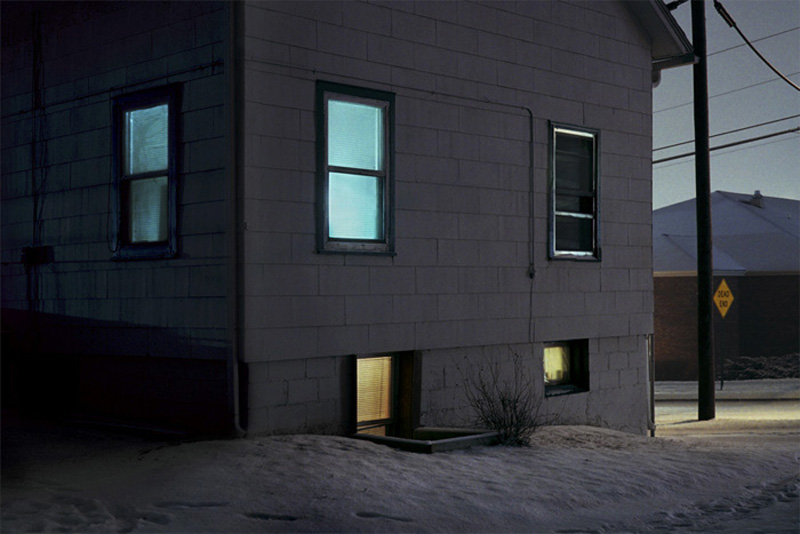
Christian Patterson / Barry W Hughes
Redheaded Peckerwood: Fact and Fear
originally published in HotShoe magazine, issue 176, 2012
_____________________________________________________________________
The cover of Redheaded Peckerwood reminds me of a Luc Tuymans’ painting called Himmler; it is a creepy monochromatic archival image with obscured face both translating as historical fact and imaginative fear. Whereas the Tuymans’ work refers to the Nazi SS Chief Heinrich Himmler, Patterson’s cover image refers to the murderous teenagers Charles Starkweather and Caril Ann Fugate. So this is the premise of Christan Patterson’s Redheaded Peckerwood, a hybrid of historical fact and imaginative fear, where the artist has set out to explore the locations and events of Starkweather and Fugate’s three day killing spree across the plains of Nebraska and Wyoming in 1957/58.
Of course when dealing with historical events such as murders we naturally try to visualise the elements not directly described by the reports. It makes for a kind of morbid entertainment that sells. The case report will only describe the bare physicality of the crime scene, so it is up to the reader to use their imagination to make it familiar and fill in the blanks. Today, we exist in a culture permeated with images of criminality; it has become a major part of American TV typified by the CSI franchise in particular; we are shown what a crime scene looks like, how it is constructed and indeed how it can be deconstructed. In a way, we can interpret Redheaded Peckerwood as a kind of crime scene deconstruction, not too far removed from that which is now common to contemporary popular culture.
One can interpret Patterson’s mixing of photographic styles throughout the book as representing this cross pollination we have come to expect. We receive information about a singular incident through a combination of sensationalist tabloids and credible news reporting, documentaries, gossip (including electronic media) and Hollywood. From the outset there are maps, and copies of original letters combined with archival and documentary style images of characters, weapons and locations in colour and black-and-white. As the book progresses we encounter more artistic images using unusual techniques and juxtaposing graphic text which not only add a more psychological aspect to the narrative, but draws the reader into 1950’s Americana. The pullouts (including essays by Luc Sante and Karen Irvine) give the reader a sense of delving into a lost case file, almost like an illicit act in itself, thus making the reader active in the investigation.
The book, though humble in its notebook size (there are a 98 images however), deals with some pretty large ideas about our own humanity. Like all good art, it uses deceptively simple methods to question our own beliefs, yet without choosing sides. One aspect of this which cannot be avoided, is the prevailent threat of violence in contemporary culture. America is a country fixated on the idea of threat; since its inception there was an external threat from the British. The Cold War defined modern America until 9/11 in recent times, but fundamentally America has always felt threatened from within. The right to bear arms itself was designed to keep the government in a state of fear of its citizens. Gun culture, and the paranoia it brings, is part of American culture and it is reflected in this book by the image “I Pledge Allegation” comprised of rows of US stamps displaying the national flag.
So while Patterson cleverly alludes to the enemy within, the story of Starkweather and Fugate isn’t one of political struggle against an oppressive system, its much scarier than that; it is about two dumb heartland American kids from working-class backgrounds who found a brief moment of purpose through the killing of others.
The term “redheaded peckerwood” is a slur on white working-class Middle Americans. Similar to “redneck” or “white trash” it is predominantly used by Southern blacks and upper-class whites, or in this case to define the background of the culprits at the heart of the story. It can be seen as a term of pathetic endearment, but then Starkweather and Fugate are completely unsympathetic characters, so there remains a sinister undertone.
Apart from the economic connotation, the term is basically a racist slur used by Southern blacks in particular, and as such has been largely adopted by white supremacists as a symbol of pride. Is this what the flat white landscape of “Looking North” hints at? This reading of the term then adds another dimension to the idea of internal threat, and just like the threat of racial violence or serial killers in America have always done, they lie hidden in clear view. They stand on the American prairie in much the same way Himmler does in that Tuymans painting, or the two “peckerwoods” do on the cover of this unique book: we know who they are, we know where they come from, but do we really know what they are going to do?